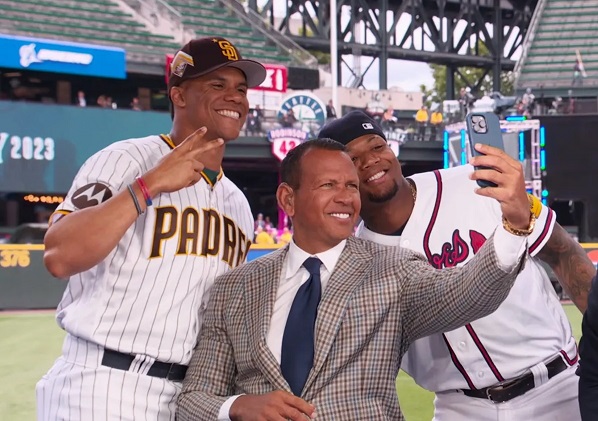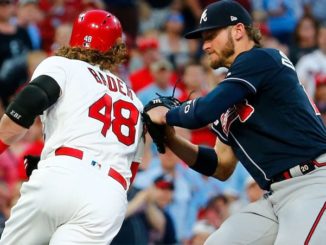
Can a team make the playoffs and still consider their season a disaster? I think the 2024 Atlanta Braves makes the case that the answer to that question can be “yes”. The team was very clear in the spring that only a World Series appearance — if not a championship — would signify a successful season. Instead the team went a respectable yet disappointing 89-73 in the regular season, 15 wins shy of the previous season’s 104. They limped into the playoffs, clinching a spot in game 162 and then getting smashed in two games by the San Diego Padres.
After six consecutive seasons of winning the division, a 2nd-place finish after a substantial drop in the standings would typically indicate a team starting a decline, but with the Braves there is equally as much evidence that it was the sign of a freakishly unlucky season. Atlanta lost their projected ace starter in his second appearance, the reigning NL MVP before the end of May, their clean-up hitter in mid-August, and had shorter but substantial injuries to the second baseman, the center fielder, the primary catcher, two other starting pitchers, and a key reliever. For just about any other club this would have sunk the team’s chances. In some ways, it was a minor miracle the team even made the playoffs, especially when you include drops in performance from most of the offensive mainstays versus their projections.
As it is, the team will look mostly to get and stay healthy in 2025, which is oddly the same place they were this time last year. In a 2023/24 offseason where many expected the Braves to be quiet however, the team made two of the best offseason moves by acquiring pitchers Reynaldo López (by free agency) and Chris Sale (by trade), two moves that were among the best made in that offseason by any team and played huge parts in allowing the Braves to overcome their hardships and still scratch for a playoff berth. I anticipate team president Alex Anthopoulos and his front office to be similarly creative this off-season in trying to improve a team that — at least on paper — doesn’t actually have that many glaring holes to fill.
Taking Stock
Despite the team’s fall from the top of the NL East standings, attendance was still strong at Truist Park and cleared the 3 million fan mark for the third season in a row, the first time the franchise has managed that trick since they did it four years in a row from 1997-2000. Atlanta Braves Holdings, Inc., the publicly-traded spin-off corporation that actually owns the club now with some backing of Liberty Media, showed a 5% increase in total revenue for the 2nd quarter 2024, with operating income up 28% to $25 million. And while the bankruptcy of Diamond Sports Group, who owns and operates the former Bally regional sports network, has disrupted the cash flow of many other teams, Atlanta has been largely unaffected so far as DSG has steadfastly kept current on its Braves agreement given its status as the network’s most profitable segment. If DSG can limp along until then, the Braves broadcast agreement goes through the 2027 season.
Atlanta has so far kept payroll apace with its revenue growth and last season the club had a franchise record $236,433,901 estimated payroll, just a hair’s breadth below the collective bargaining agreement’s luxury tax threshold. Anthopoulos has indicated that the payroll will increase again in 2025, and if it simply keeps pace with the threshold it could rise to as much as $241 million. If the team decides it can stomach the 20% penalty on overages over the threshold, the payroll could rise as high as $261 million without incurring additional surcharges, but for the purposes of this piece I will be assuming the team will look to keep payroll at or below the threshold.
The Atlanta Braves are still the envy of most clubs in that they have so much of their core on cost-controlled long-term deals. Third baseman Austin Riley; first baseman Matt Olson; outfielders Ronald Acuña Jr., Jorge Soler, and Michael Harris II; catcher Sean Murphy; starting pitchers Chris Sale, Reynaldo López, and Spencer Strider; shortstop Orlando Arcia; second baseman Ozzie Albies; and relievers Raisel Iglesias, Joe Jimenez, and Pierce Johnson are all locked into long-term deals and will be returning to the club barring off-season trade and represents $178 million in payroll, leaving the team with $63 million before touching the luxury tax threshold.
The team also holds club options on designated hitter Marcell Ozuna, catcher Travis d’Arnaud, and relievers Aaron Bummer and Luke Jackson. It is expected that that Atlanta will exercise their options on Ozuna, d’Arnaud, and Bummer, which would add $31.25 million to the payroll, jumping it to a total of $209.25 million, or $31.75 million below the threshold.
Finally, the Braves have six players that have enough service time to qualify for the salary arbitration process: infielder Calvan Biggio; outfielders Ramon Laureano, Jarred Kelenic, and Eli White; and pitchers Huascar Ynoa and Dylan Lee. Biggio and Ynoa seem likely to be non-tendered (or signed at reduced prices ahead of the non-tender deadline) while Kelenic, White, and Lee seem likely to be retained. Laureano is an interesting case in that he finished the season strong with Atlanta but the team has a seeming surplus of outfielders at the moment and Larueano is estimated by the typically reliable MLB Trade Rumors to make around $6.1 million in the arbitration process. That’s not an unreasonable salary, but perhaps not one that fits for Atlanta. If they non-tender Laureano, the estimated combined salaries for Kelenic, White, and Lee come to around $4.3 million, raising our projected payroll to $213.55 million. That would leave around $27.45 million with which the Braves could work with.
Priority 1: sign or replace Charlie Morton
OK, I’m being a little cheeky with this, but hear me out. Both Max Fried and Charlie Morton will be free agents at the start of the 2024-25 off-season. Fried has been the Braves ace or co-ace since 2020 and the loss of his production would be a big issue for this rotation — IF the Braves didn’t already have an in-house replacement in the form of right-hander Spencer Strider, who should, barring setbacks, return to the mound at some point this spring. A top four of Sale, Strider, López, and 2024 rookie standout Spencer Schwellenbach should be able to equal or exceed the production of Sale, Fried, López, and Schwellenbach from last season.
If Morton does sign elsewhere or, perhaps more likely, retire, that would mean the 5th spot in the rotation would be a big question mark for the club. They could fill from within of course, with game 162 starter Grant Holmes likely the favorite for the role with prospects AJ Smith-Shawver, Hurston Waldrep, and Drue Hackenberg likely given long looks in the spring along with veterans Bryce Elder and Ian Anderson.
The Braves have a lot of options here, from bringing in an established veteran on a major league deal, making a trade, or bringing in pitchers on no-risk minor league deals to compete with the 5th starter candidates listed above.
My preference here would be to re-sign Max Fried, but I will admit to personal bias. It is unknown what he’s looking for in a contract, but if the Braves wanted to meet his ask, its likely they would already have been done, so a reunion seems unlikely. The projected starting pitching free agent market is particularly thin this season with Corbin Burnes, Yusei Kukuchi, Fried as the only real head-of-a-rotation level talent. Below them are solid pitchers with some recent track record question marks in Jack Flaherty, Nick Pivetta, Andrew Heaney, Walker Buehler, and Luis Severino. I think it’s more likely that Atlanta explores the trade market, with several teams announcing plans to reduce payroll in the wake of the collapse of the Bally regional broadcast network in many other markets.
The hottest name on the trade market will likely be White Sox ace Garrett Crochet, and there were rumors that Atlanta made a run at him at the trade deadline. Perhaps Anthopoulos and Chicago GM Chris Getz revisit those talks. After the Diamondbacks made derogatory statements about him, righty Jordan Montgomery will almost have to be moved and would be an intriguing bounce-back candidate.
Intriguing options for one-year deals would include future Hall of Famers Max Scherzer or Justin Verlander — or even Charlie Morton himself for one more ride.
Priority 2: improve infield depth
Depending on which version of WAR you looks at, the Braves finished between 27th and 30th at the shortstop position in 2024. This was largely due to Orlando Arcia cratering his offensive production after a solid 2023 season. His defense at the position is good enough to tolerate average or below offensive value, but a 72 wRC+ may be a bridge too far, even for an organization that highly values defense at the position, at least as much as other clubs. As he enters his 10th major league season at age 30, there is an increasing likelihood that we’ve already seen the best that Arcia has to give.
That said, even with the season he had Arcia’s $2 million salary for 2025 is a substantial bargain for the club considering the defense he brings, and it would look just as good if Arcia was a depth player rather than a starter. With Olson, Albies, and Riley locked in at the other three infield spots, the Braves could elect to invest at shortstop.
The potential in-house upgrade option is in the form of prospect Nacho Alvarez Jr. Alvarez will turn 22 years old a week after Opening Day, making him a very young option for the position, but he has a potential impact bat for the lower part of the line-up and is a quality shortstop, though he won’t have Arcia’s range at the position. Alvarez was an emergency call-up in August when Albies and back-up Whit Merrifield were injured and he struggled at the plate his in his eight games. It’s possible he will still need additional seasoning at triple-A to start 2025, leaving Arcia as the starting shortstop until Alvarez is deemed ready to take over.
The Cadillac option on the free agent market is Willy Adames, most recently of the Milwaukee Brewers. Adames has averaged 3.9 fWAR over the last four seasons and is coming off his best offensive season to date. He will only be 29 years old next year and will looking to command a contract somewhere around the 7-year, $177 million deal signed by Dansby Swanson with the Cubs two years ago. Given that Atlanta was not willing to match that for Swanson, a hometown talent, it seems unlikely the will do so for Adames.
After Adames, the free agent pool gets shallow quickly, leaving the trade market a more likely avenue to explore. A number of teams have talented potential MLB shortstops blocked by young established veterans such as St. Louis’s Thomas Saggese (blocked by Masyn Winn), Baltimore’s Jordan Westburg (blocked by Gunner Henderson), the Mets’ Jett Williams (blocked by Francisco Lindor), or Minnesota’s Brooks Lee (blocked by Carlos Correa). If the Braves believe any of these players would be a potential upgrade over Arcia and/or Alvarez they could become trade targets.
If the Braves look to “go big” in the trade market, there would be no bigger names than the Rangers’ Corey Seager or Marcus Semien. The Rangers have signaled that they are looking to cut payroll to get back under the luxury tax threshold after a disappointing 3rd-place finish in 2024, and trading out either of their infielders would go a long way to helping them do so. Of the two, Semien has been the more reliable, averaging 161 games a season over the last four seasons. Last year was a down season offensively, as he hit .237/.308/.391, one year removed after a career-best .276/.348/.478. If the Rangers want to move on from Semien they would likely have to pay down some of the $98 million he is owed over the final four seasons of his contract, which runs through his age 37 season.
Seager provides more production, though he too is coming off a down year (for him) where he batted “only” .278/.353/.512. With the production however comes substantial risk. He was always a somewhat fragile player with the Dodgers, and while he has played more since signing with Texas, he still has only averaged only 131 games over his three seasons with the Rangers. There’s also the small matter of the staggering $221.5 million he will be owed over the next 7 seasons of his contract, which like Semien takes him through his age 37 season. That all said, a healthy Seager would be a dynamic addition to the Braves line-up.
Priority 3: clear up the DH logjam
It’s typically never a real problem to have “too many” good options at a position, but when the position is designated hitter it can create some roster problems. In Atlanta’s case, the logjam occurs because of the mid-season acquisition of Jorge Soler, who is under contract for the next two seasons for $32 million. He was acquired to help fill the offensive shortfall brought about by Acuña’s injury, and while he hit well enough his defense in right field was even worse than in his previous short stint in Atlanta back in 2021.
He would naturally be a candidate to be the team’s designated hitter, the role Soler was assigned with the Giants prior to the trade. However, if the Braves as expected bring back Marcell Ozuna on a $16 million club option, the team would have two would-be outfielders that probably shouldn’t play outfield. Add to that is the uncertainty over how much Acuña will need to rest his second surgically reconstructed knee next year and you have the possibility of having essentially having 3 DHs, forcing one of Soler or Ozuna into the outfield when Acuña is the DH and the other to the bench. This is, to put it mildly, an inefficient deployment of assets.
Obviously the Braves could simply decide not to pick up Ozuna’s option, but given his outstanding performance in 2024 that would be foolhardy. Instead the Braves will likely look to trade one of Soler or Ozuna, or both.
With only the one year remaining on his deal, Ozuna would seem to be the easier player to trade, though it would likely be an unpopular move in the clubhouse. Soler’s $32 million pricetag wouldn’t command as much of a return, but Anthopoulos would still likely be able to find a taker. Given a choice, I would reluctantly prefer to move Ozuna because of the defensive dynamic. If Acuña has to DH for any significant amount of time, Soler could fill in right field easier than Ozuna.
Priority 4: forget about the luxury tax and go for it
Look, it’s not my money. While I have no desire to lose draft positioning or slots, the Braves are unquestionably still in a window of contention. How can the Braves best lengthen that window? The answer at this point given Atlanta’s relatively lackluster farm system is to simply hire very good players to play for you. Juan Soto is a free agent. Sign him, let him play left field, and have the best one-two hitters in baseball history (maybe) when you pair him with Acuña. Trade for Seager or sign Adames. Re-sign Fried, or bring in Corbin Burnes. Raisel Iglesias had one of the best all-time seasons by a closer in 2024 — let’s add Tanner Scott as his 8th-inning warm-up act who can also step in and close on occasion.
Let’s live a little.




Leave a Reply